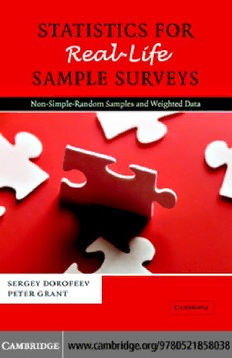Table Of ContentThis page intentionally left blank
StatisticsforReal-LifeSampleSurveys
Non-Simple-RandomSamplesandWeightedData
Samplesusedinsocialandcommercialsurveys,especiallyofthegeneralpopulation,
areusuallylessrandom(oftenbydesign)thanmanypeopleusingthemrealise.Unless
itisunderstood,this‘non-randomness’cancompromisetheconclusionsdrawnfrom
the data. This book introduces the challenges posed by less-than-perfect samples,
givingbackgroundknowledgeandpracticalguidanceforthosewhohavetodealwith
them.Itexplainswhysamplesare,andsometimesshouldbe,non-randominthefirst
place;howtoassessthedegreeofnon-randomness;whencorrectionbyweightingis
appropriate and how to apply it; and how the statistical treatment of these samples
mustbeadapted.Extendeddataexamplesshowthetechniquesatwork.Thisisabook
forpractisingresearchers.Itisareferenceforthemethodsandformulaeneededto
dealwithcommonlyencounteredsituationsand,aboveall,asourceofrealisticand
implementablesolutions.
TheauthorsarefromRoyMorganResearch,Australia’sbest-knownmarketandsocial
research,publicopinionandpoliticalpollingorganisation.
SergeyDorofeevisTechnicalDirectorofRoyMorganInternational,theglobalarm
ofRoyMorganResearch.
Peter Grant was Research and Development Manager in the Melbourne head
office.
Together they have more than 50 years’ experience of commissioning and con-
ductingsurveyresearch.
Statistics
for Real-Life Sample Surveys
Non-Simple-Random Samples and
Weighted Data
Sergey Dorofeev and Peter Grant
Roy Morgan Research, Melbourne, Australia
Cambridge, New York, Melbourne, Madrid, Cape Town, Singapore, São Paulo
Cambridge University Press
The Edinburgh Building, Cambridge , UK
Published in the United States of America by Cambridge University Press, New York
www.cambridge.org
Information on this title: www.cambridg e.org /9780521858038
©S.DorofeevandP.Grant2006
This publication is in copyright. Subject to statutory exception and to the provision of
relevant collective licensing agreements, no reproduction of any part may take place
without the written permission of Cambridge University Press.
First published in print format 2006
- ---- eBook (EBL)
- ---
eBook (EBL)
- ---- hardback
- --- hardback
- ---- paperback
- --- paperback
Cambridge University Press has no responsibility for the persistence or accuracy of s
for external or third-party internet websites referred to in this publication, and does not
guaranteethatanycontentonsuchwebsitesis,orwillremain,accurateorappropriate.
Contents
Preface pagevii
1 Samplingmethods 1
1.1 Accuracyandprecision 3
1.2 Design effect and sample size 4
1.3 Definingtheobjectives 5
1.4 Definingtheconstraints 9
1.5 Definingthepopulation 10
1.6 Samplingframes 11
1.7 Simplerandomsampling 16
1.8 Multi-stagesampling 17
1.9 Stratification 18
1.10 Post-stratification 22
1.11 Systematic(interval)sampling 23
1.12 Clustersampling 24
1.13 Complexsamples 25
1.14 Selectionwithunequalprobability 25
1.15 Non-response 32
1.16 Quotasampling 36
1.17 Othernon-probabilitysamplingmethods 41
1.18 Samplingsmallpopulations 42
1.19 Somefinalthoughts 43
2 Weighting 45
2.1 Principles 45
2.2 Methodsofweightingsamples 51
2.3 Cellweighting 52
2.4 Marginalweighting 55
2.5 Aggregateweighting 66
2.6 Multi-stageandhybridweightingsystems 74
v
vi contents
2.7 Statisticalconsiderations 75
2.8 Ethicalconsiderations 77
3 Statisticaleffectsofsamplingandweighting 79
3.1 Calculationofvariance 80
3.2 Designeffectandeffectivesamplesize 90
3.3 Weightingeffectandcalibratedsamplesize 105
3.4 Missingdata 132
4 Significancetesting 140
4.1 Thepurposeandphilosophyofsignificancetesting 140
4.2 Principlesofsignificancetesting 151
4.3 Choosingatest 155
4.4 Testingparticularvaluesofameanorproportion 157
4.5 Testingthedifferencebetweenmeansorproportions 159
4.6 Thechi-squaretestoffit 165
4.7 Testinghomogeneityandindependence 168
5 Measuringrelationshipsbetweenvariables 172
5.1 Analysisofcontingencytables 172
5.2 Multivariatetechniques 192
5.3 Regressionanalysisforweighteddata 197
5.4 Classificationandregressiontrees 200
5.5 Clusteranalysisforcategoricalvariables 206
5.6 Datafusion 215
AppendixA: Reviewofgeneralterminology 227
AppendixB: Furtherreading 237
AppendixC: Summarytablesforseveralcommondistributions 239
AppendixD: Chapter2mathematicalproofs 241
AppendixE: Chapter3mathematicalproofs 244
AppendixF: Chapter4mathematicalproofs 249
AppendixG: Chapter5mathematicalproofs 250
AppendixH: Statisticaltables 255
References 261
Index 264
Preface
Yetanotherbookonthestatisticsofsamples:whatcantherebelefttosay?Indeed
there is a very large choice of titles on statistics and sampling and most of what is
inthisbookcanbefoundsomewhereinthepublishedliterature.Therearetwomain
kinds of book in this area. One kind presents the statistics of simple samples in a
simplistic way, based on the application of pure probability theory, and is inclined
toglossoverthefactthatrealityisrarelythatsimple.Theotherkinddealswiththe
complexities of complex samples, but often in a way that anyone but a specialist
mathematician will find daunting. Our purpose is to provide an appreciation of the
statisticalissuesinvolvedinreal-lifesamplesurveysandpracticalguidanceonhow
tocopewiththem,withoutlosingsightoftheneedtoremaincomprehensibletothe
non-mathematician.
Qualified professional statisticians, particularly those whose interest lies mainly
in the assessment of sampling and non-sampling survey error, may find this book
too superficial. But it is intended primarily for practising researchers whose main
concernistoextractmeaningfromsurveyresultsandtoapplyitintheformulation
of plans and policies, and who may have only basic formal statistical training. We
assumeareasonablelevelofnumeracy,butthosewhoarenotmathematicallyinclined
shouldnotbeputoff.Ourfirstaimistoimpartanunderstandingoftheissuesandthe
principlesinvolved,forwhichonlyrudimentarymathematicsisrequired.Themore
advancedformulaeandtheproofsarethereforthosewhocanmakeimmediateuse
ofthemandasasourceofreferenceforthosewhomayneedtheminthefutureor
whomayneedtoreferotherstothem.
The content of this book is intentionally selective. We do not intend it to be a
generalintroductiontotheverybroadsubjectsofsamplingorstatistics.Weassume
thatreadersarealreadyfamiliarwiththebasicprinciplesofthestatisticsofsamples
fromothertexts,butstandinneedofsomehelpinapplyingwhattheyhavelearned
inthemorecomplicated‘realworld’,wherepracticalproblemsloomsomuchlarger
thantheydidinthetextbookexamples.
Ourexperienceprovidesuswithtwospecificstimulitowrite.Firstly,wehavelost
countoftheresearcherswehavemet,manyofthemwithformalqualificationswhich
includestatistics,whowereignorantofsomeofthefundamentalissuesinvolvedinany
vii
viii preface
deviationfromsimplerandomsamplingbecausetheyhadneverseenthemexplained
inpracticalterms.Fortheseresearchersacompactsourceofreferencewhichcovers
the basic, and some of the not-so-basic, principles of sampling and evaluation of
sample-baseddatacanbeofvalue.Thisshouldbeespeciallytruebecauseweexplain
the mathematical and mechanical processes of sampling and data analysis, and try
to show the reasoning behind them, some of their implications and some of the
pitfalls.
Secondly, and more importantly, there are two subjects of considerable practical
importancethatarenotwellservedbythemoreaccessibleliterature.Ingeneral,our
experienceisthatbasictextbooksareinclinedtopresentanunreasonablyoptimistic
pictureofthequalityofthesampleswithwhichtheirreaderswillhavetowork.We
aimtoprovideareviewoftheproblemsassociatedwiththeevaluationofreal-world
sample-based data and practical guidance on coping with them. In particular we
examinetherelatedquestionsofthetreatmentofsamplesotherthansimplerandom
onesandthepracticeandimplicationsofweightingdata.
Weightingisasubjectwhichismentionedbrieflyifatallinthemaintextbooksand
aboutwhichmanyresearchersappeartoknowverylittle.However,inpracticevery
manysurveyshavethedataweightedattheanalysisstage,foravarietyofreasons.
Weighting has important implications for the assessment of results, especially in
the calculation of confidence intervals and in significance testing. Users of popular
statisticalsoftwarepackagesareoftenunawareofsomeofthethingsthatthesemay
dowithweighteddata.
Thisbookbringstogetherinacompactformtheessentialmaterialforunderstanding
and coping with the most salient problems of non-simple-random samples. Almost
allofthetheoreticalmaterialitcontainsisavailablefromothersources,butmuchof
thatistobefoundinspecialistbooksandjournalsthatmaynotbereadilyaccessible,
even to those who know what to look for. We aim to provide an awareness and
understanding of the main factors in sample design and planning and the practical
realities of sample selection and recruitment, their likely effects and the allowance
thatshouldbemadeforthemininterpretingresults.Weparticularlyaimtoprovide
the practising researcher with a source of reference for the methods and formulae
necessarytodealwiththemostcommonlyencounteredsituationsandaboveallwith
practical,realisticandimplementablesolutions.
Wehavealsoincludedashortreviewofsomeofthemorecommonanalyticaltools
usedwithsurveydata.Ifweseemslightlylessthanenthusiasticinourendorsement
oftheseitisbecauseexperiencehastaughtustobecautiousinapplyingsophisticated
mathematical procedures to data that may be considerably less sophisticated. It is
understandable that researchers should be keen to exploit any technique that will
squeezemoreinformationoutofadatasetamassedwithmuchtroubleandexpense,
buttherearepitfallstobeavoided.Weseektotemperthatenthusiasmratherthanto
bluntit.
Wecouldnothaveproducedabooksuchasthisunaided.Weexpressourthanksfirst
ofalltoRoyMorganResearchofMelbourne,Australia,forprovidingthesupportand

